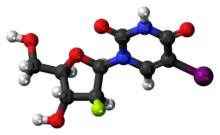Fialuridine
 | |
 | |
| Clinical data | |
|---|---|
| Other names | 2′-Fluoro-5-iodouracil |
| ATC code |
|
| Identifiers | |
IUPAC name
| |
| CAS Number | |
| PubChem CID | |
| ChemSpider | |
| UNII | |
| KEGG | |
| ChEMBL | |
| NIAID ChemDB | |
| Chemical and physical data | |
| Formula | C9H10FIN2O5 |
| Molar mass | 372.091 g·mol−1 |
| 3D model (JSmol) | |
SMILES
| |
InChI
| |
| | |
Fialuridine, or 1-(2-deoxy-2-fluoro-1-D-arabinofuranosyl)-5-iodouracil (FIAU), is a nucleoside analogue that was investigated as a potential therapy for hepatitis B virus infection. In a 1993 clinical study at the NIH, unexpected toxicity led to the death of 5 out of 15 patients from liver failure alongside lactic acidosis; two further participants required liver transplantation. This toxicity was unusual in that it was not predicted by animal studies. It is suspected that the drug's toxicity was due to its ability to damage mitochondria.[1][2][3]
References
- ↑ Tujios S, Fontana RJ (April 2011). "Mechanisms of drug-induced liver injury: from bedside to bench". Nature Reviews. Gastroenterology & Hepatology. 8 (4): 202–11. doi:10.1038/nrgastro.2011.22. PMID 21386809. S2CID 1329655.
- ↑ McKenzie R, Fried MW, Sallie R, Conjeevaram H, Di Bisceglie AM, Park Y, et al. (October 1995). "Hepatic failure and lactic acidosis due to fialuridine (FIAU), an investigational nucleoside analogue for chronic hepatitis B". The New England Journal of Medicine. 333 (17): 1099–105. doi:10.1056/NEJM199510263331702. PMID 7565947.
- ↑ Thomson L (1 March 1994). "The Cure that Killed". Discover Magazine. Retrieved 2 November 2013.
This article is issued from Offline. The text is licensed under Creative Commons - Attribution - Sharealike. Additional terms may apply for the media files.